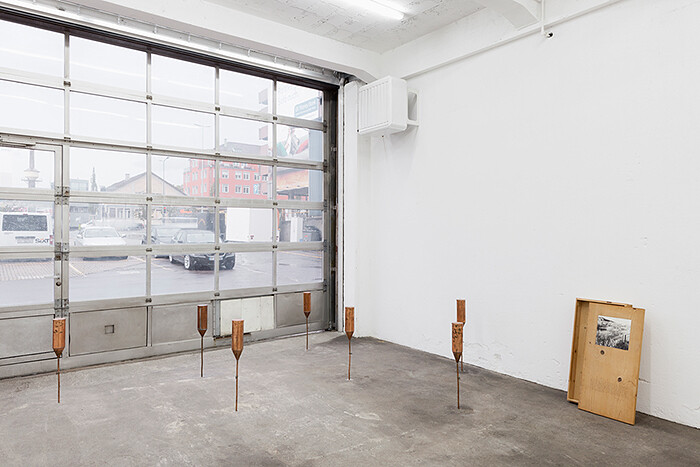Much discussion of performance or Land Art from the 1960s and 70s considers whether the art consists of the work itself or its documentation. Could it really be experienced secondhand? Was the art the idea … or the stuff of it? Such recondite questions had to be put in the closet when it came to making saleable works in order to live, and few artists of note have ever proven themselves capable of true disinterest in the career element of being an artist.
In 1974, the artist Robert Kinmont walked away from a successful practice to support his family by other means, first of all by founding a school of sorts, then devoting time to the study of meditation, and later working as a carpenter. His return to making art was not for three decades, but, despite that lacuna, his work has rapidly re-found an audience. It’s the first time his art has been seen in Europe, and at that, in three shows: here in Switzerland at RaebervonStenglin; though an exhibition at the Fundación La Caixa in Barcelona, which will travel to Madrid hot on its heels; and the LA MOCA exhibition “Ends of the Earth: Art of the Land to 1974” will be shown at the Haus der Kunst in Munich later this year.
In light of Kinmont’s engagement with Buddhism during his time away from making art, it’s easy to conceive of his work being koan-like, a reading that allows it an inexplicable core, but the work continues where he left off, indeed expanding on previous series, to challenge any easy outs. “Wait” opens with the 1972 work Copper Pots (given a chance), a group of copper vessels and the box for their storage, on which their purpose is chronicled. Kinmont had placed them upright in the desert and filled them with water that was to drip slowly into the aridland, with the hope of germinating dormant seeds. As he fed the containers, this ambition (which was never realized) became secondary to his method of marking and finding his way back to them on each visit with the least possible scarring of the landscape. The piece has been shown before in its case, but here it forms a miniature lighting field rooted in the bruised concrete floor of the gallery.
Kinmont’s backyard in northern California is harsh, endless, and extreme, though beautiful and fertile, in a manner, too. It is omnipresent here—in the images, the materials, the physical dryness of it all. Another early work, My Favorite Dirt Roads, 1969 (remade in 2008) further elucidates Kinmont’s relationship with his home; sixteen black-and-white images of roads run away from the artist and the viewer. The land takes center stage, barren but mediated, charted by the roads running through it. Here in Switzerland, the contrast between the European and the North American understanding of land is marked—beyond RaebervonStenglin’s industrial space, rural Switzerland is dramatic, verdant, and closely managed, with barely a square meter that is not part of a concentrated agricultural ecosystem, yet generally more accessible than American wildernesses. A further remade piece suggests that the two locations are not, however, worlds apart culturally: Standing here in front of these mountains is success (1970/2012) spells out the work’s title in copper tubing that is being chilled to the point that ice gathers on it. The mountains are absent but we stand in front of an imagined, experienced, landscape (and note man’s modest triumph of interaction).
Kinmont’s contemporary practice retains the appearance of his older work, but its patina is now advantageous, for if environmental damage has increased in the meanwhile, popular conceptions of the planet have conversely become ever more romanticized. Kinmont’s work is grounded and realistic; it claims neither impotence nor omnipotence, but an unassuming engagement with the quotidian. His quotidian is both raw matter and the ideas that we bring to it, as a recent continuation of his log series suggests: Log Filled with Dirt (2007) is a stripped tree trunk with two sections cut out. Inside one end, we are told, is dirt, inside the other, toys, but both openings have been resealed. To the viewer, the contents are as present as the mountains summoned by writing in ice.







